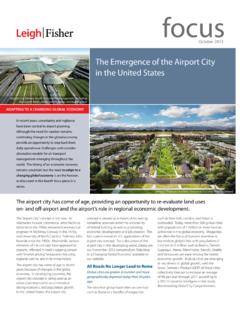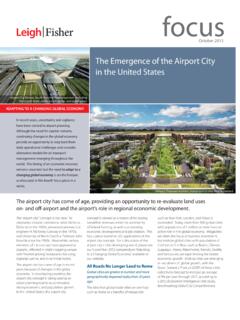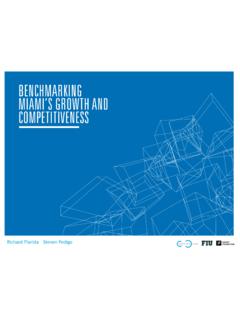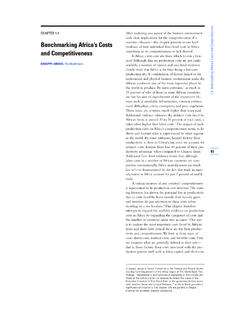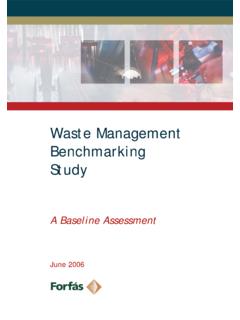Transcription of Knowledge cities and Smart cities
1 Knowledge Economy Network, Brussels Weekly Brief No. 20 May 2012 Knowledge cities and Smart cities cities have always been home of Knowledge , and in return being nurtured and protected, it helped them develop, grow and prosper. Nowadays, we talk about Knowledge , science, innovation, technology, and lately also about Smart cities . With modern focus on Knowledge -based competitiveness the terminology is often used inconsistently because the concepts have not been defined precisely and unequivocally, at least as yet. Many cities around the globe have realized that their performance does not depend just on the city s size of population, production facilities and physical infrastructure, but even more on availability and communication of Knowledge and their social and intellectual capital. Smart cities distinguish themselves from their more technology-laden counterparts, by successful application of Knowledge and technology in a consistent framework, benefiting from the growing importance of ICT, social and environmental capital, and they are becoming also an important marketing concept and instrument.
2 By 2050 it is estimated that urban dwellers will account for 86 percent of the global population in the more developed and 67 percent in the less developed regions. Overall, it is expected that 7 out of 10 people will be living in urban areas by 2050. The surge and concentration of human populations will not only put increased strain on the world s ecosystem, but also pose even greater challenges on quality of life. As with every challenge, there is opportunity to create sustainable, energy efficient cities of the future. For instance, in Europe buildings account for 40 - 45% of energy consumption alone, contributing to significant amounts of carbon dioxide (CO2) emissions. In January of this year, Economist Intelligence Unit a sister company of The Economist published a new index which ranks the competitiveness of the 120 cities across the globe using a number of economic, demographic and social variables.
3 While economic size and growth are important and necessary, several other factors determine a city s overall competitiveness , including its business and regulatory environment, the quality of human capital and indeed the quality of life. Below you ll find the Index scores of the overall top 10 and by category. 2 At one level, it can be assessed to what degree a city has managed to develop based on best available Knowledge , know-how and technology. The more it has succeeded in this direction the higher it should be scored at the Economist Intelligence Unit s new index of city competitiveness . At another level we have a number of cities having qualified by many criteria as Smart cities , but have adopted a strategy by which they have made Knowledge production and dissemination (research, education, consultancy) their particular focus and have achieved as such an internationally recognized niche (regional or even global ) as a Knowledge , Science , Technology , Innovation or Education city .
4 In the first case Knowledge has been successfully applied to make a city internationally competitive obviously in some domains more than in others. In the second case, a city is recognized internationally for its role as Knowledge center, of course with excellence in only some domains of Knowledge production, innovation and education. The Smart city has managed to resolve most of its practical problems (from urban planning, environment, transport, energy management, etc.), but it may not have the intention and capacity to systematically focus on further research and innovation, as well as consulting and education services to be offered to other cities . A Knowledge city however may not have solved several of its practical problems, but has developed excellent R&D, training and education capacity and services in certain domains and is offering them systematically to other interested parties in the region or worldwide.
5 This distinction is of course primarily of conceptual nature, while in reality there are always elements of one and the other in each city around the globe. What is essential for qualifying a particular city as Smart or Knowledge city is the proportion of the two elements. Normally, a Smart city can build on previous achievements of an organic growth , while a Knowledge city is usually a result of a governmental project, not necessarily being a part of an existing city , but also not too far from one. Also, to illustrate this distinction at the practical level one has to compare cities primarily within their own size category (mega city or large metropolis with over 5 million people, big cities with characteristically 3-5 million people, medium-sized cities - with up to a million, and small cities bellow half a million people).
6 In other words, a small Knowledge city cannot be compared by its Knowledge capacity and output with a megapolis, but in certain areas the small Knowledge city may have achieved a level of expertise and globally recognized excellence not to be found in any megapolises around the globe. At the same time the research personnel and infrastructure to be found in a megapolis as part of the normal landscape of an agglomeration of some 10 million people, would have a very different position and function in a science city with a population of maybe only several ten thousand people. To summarize the criteria for a Knowledge city as a very new and still vaguely defined concept the following three elements could be singled out:: 3 The relative size and impact of Knowledge -related activities vis- -vis the overall economically relevant activities in a particular urban environment; The volume and quality of human capital, equipment, infrastructure and capital available for the above mentioned activities.
7 The Knowledge city blueprint strategy - effectively supported by relevant authorities and economic interests, with ambitions to fulfill a specific role in building Knowledge -based, international competitiveness for a region or a country, and offering Knowledge services to a wider international market. The concept of Knowledge city has its early origins probably in the world-famous Silicon Valley which has been the inspiration for numerous attempts to transplant it onto other locations in US and around the globe. However, these attempts have been largely unsuccessful obviously because one or several of critical ingredients were missing. There are brilliant researchers and innovators, as well as ambitious and aggressive entrepreneurs in many parts of the world.
8 But the right mix of entrepreneurial and innovative culture combined with abundantly available venture capital, favorable tax incentives and government support for young companies, and a large, highly competitive, sophisticated market, eager to accept new products and technologies cannot be easily transplanted from California, even to many aspirant cities and regions in the US. And strangely enough, the concept of Knowledge city has not been used in reference to Palo Alto, California which developed by itself and was not created top-down by a government decision or by an ambitious private investor. It is an initiative that grew organically from below. However, the concept appeals to others who decided to create an intensive Knowledge -production entity in a geographically limited, urban area.
9 Historically one of the earliest science cities have been created in Soviet union already in the 1950s, focusing on secret research on nuclear arms and space, with particular motivation and concern of communist authorities of the day to achieve total isolation of those scientists from the rest of Soviet society, let alone the wider world. During the 1960s Western Europe has experienced intensive development of science and technology parks called technopolis in France. They were normally linked to research intensive universities and located at the outskirts of major cities . Many of them managed to provide a support environment to university spin-offs and other young technology companies predominantly from the region. With a number of positive exceptions ( : the largest and one of the oldest in Europe Area Science Park near Trieste, Italy) most of technology parks achieve modest results in boosting R&D activities in their regional environment, simply because there was limited research and business interaction among the companies in the park, and the main reason for members of the park to be there remained in utilizing the physical facilities (mostly subsidized office and laboratory space).
10 Also, most of the park management teams did not have the capability to be involved in marketing the products and helping members obtain the needed R&D funds. The most notable and grand example of modern Knowledge city is the Qatari Foundation s Education city built completely from scratch and covering an area of 14 million square meters. The Education city aims to be the center of educational excellence in the Gulf, and has partnered with world class universities (such as Cornell University, Georgetown University and Carnegie Mellon University). Qatar Foundation has also launched the World Innovation Summit for Education WISE a global forum which discusses exclusively educational issues. 4 What makes a city Smart remains rather arbitrary and can encompass various concepts.
